The recent disengagement of troops from the LAC by India-China has grabbed international attention that has become the talking point among both the experts as well as the common man on the streets. While most experts are baffled and unable to connect the dots and the dashes to decode the abnormal response of the Chinese, the new generation in India, on the other hand who comprise the majority of population, feels that the Chinese have reacted perfectly normal. The present generation who do not carry the painful baggage of the past humiliation resonate the mood of a determined leadership and a tough military who can give it back as good as it comes. The rest of the world has reacted guardedly, welcomed the development and are watching with bated breath how the future unfolds leading to a lasting peace.
The disengagement exercise is a manifestation of some hard bargaining by both sides based on sound ground realities. It has consumed twenty brave hearts, nine rounds of painfully long and arduous talks to come to settlement that was as unusual as it was historic. Never before had Chinese shown so much restraint or withdrawn their forces under pressure. The talks which had started soon after the Galwan clash had taken nine long months to reach a decision which is a step to move forward and hold more talks for a permanent resolution of the border dispute.
Political analysts and China Watchers will be carefully studying the entire developments with a fine comb and try to unravel the inscrutable mystery. Professional political analysts will further analyse and come to definite conclusions as details get unraveled. But for the present, here are TEN reasons why China agreed to the disengagement.
1. PLA CASUALTIES
The Chinese had not expected severe retaliation by Indian troops at Galwan. The clashes had been brutal. Foot soldiers of two nuclear powers were at each other’s throats with clubs and stones as their weapons. PLA had displayed their strongest traits of betrayal of a soldiers code. 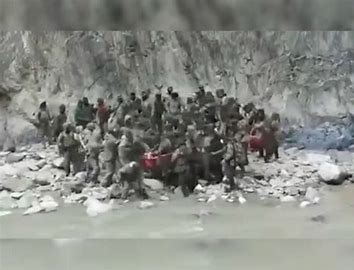 The Chinese had ostensibly to negotiate but were fully equipped and mentally prepared for a show down. An attempt was made to give an impression that the clash was not pre-meditated and that it was not spontaneous. But the preparations gave away their real intentions. Some of the most primitive and improvised weapons were mobilized to beat the Indian soldiers who were taken by surprise. The sheer ferocity and the intensity of violence shook the world. Twenty bravemen led by a fearless Battalion commander went down fighting. The number of casualties on the Indian side was in the public domain right from the day they were martyred. It is open secret that the PLA lost many more soldiers. By concealing figures and pretending as if nothing had happened China has only landed herself in mess. Recent report from Russia indicate that the Chinese casualties were around 45 men. Other reports suggest them to be much higher. This must have shaken both the Chinese political and military leadership. Any further escalation would have meant loss of PLA’s reputation of invincibility. Indian troops had thrashed the PLA soldiers soundly calling out the Chinese bluff.
The Chinese had ostensibly to negotiate but were fully equipped and mentally prepared for a show down. An attempt was made to give an impression that the clash was not pre-meditated and that it was not spontaneous. But the preparations gave away their real intentions. Some of the most primitive and improvised weapons were mobilized to beat the Indian soldiers who were taken by surprise. The sheer ferocity and the intensity of violence shook the world. Twenty bravemen led by a fearless Battalion commander went down fighting. The number of casualties on the Indian side was in the public domain right from the day they were martyred. It is open secret that the PLA lost many more soldiers. By concealing figures and pretending as if nothing had happened China has only landed herself in mess. Recent report from Russia indicate that the Chinese casualties were around 45 men. Other reports suggest them to be much higher. This must have shaken both the Chinese political and military leadership. Any further escalation would have meant loss of PLA’s reputation of invincibility. Indian troops had thrashed the PLA soldiers soundly calling out the Chinese bluff.
2. INDIA’S STRATEGIC MOBILITY
Soon after the incident China moved their Formations in an offensive mode as if poised for mounting an attack. The Indian reposte to the Chinese move stunned the PLA. Indian Army moved almost 50,000 troops within less than a week. This massive movement of Formations, Tanks, guns and heavy equipment along with matching logistics was an exercise in strategic mobilization. The strategic air effort to lift such mind boggling numbers of men and equipment baffled not just the Chinese but also many in the international media. It can be called the jaw dropping moment for the Chinese who had suffered heavy casualties during the fist fighting. Indian Army capability to mobilize such large forces and the Air capability to transport these assets must have rattled the Chinese.
The strategic air effort to lift such mind boggling numbers of men and equipment baffled not just the Chinese but also many in the international media. It can be called the jaw dropping moment for the Chinese who had suffered heavy casualties during the fist fighting. Indian Army capability to mobilize such large forces and the Air capability to transport these assets must have rattled the Chinese.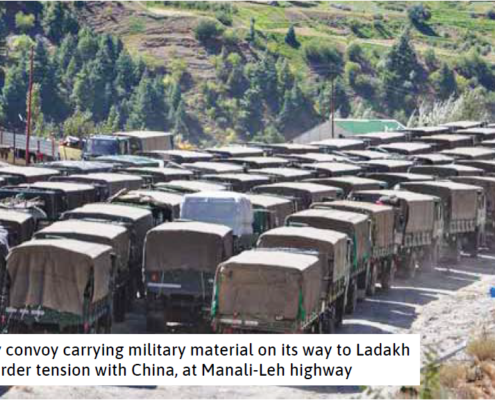 All these even as India was grappling with the pandemic, Covid19.
All these even as India was grappling with the pandemic, Covid19.
3. CAPTURE OF KAILASH HEIGHTS
The capture of Kailash heights on the southern edge of Pangong Tso lake in a lightning move completely outwitting the PLA was the next surprise that the Chinese had not anticipated. The Chinese tanks found the Indian Units dominating heights and staring straight in their face. This was the defining moment.  Even if one Indian soldier had panicked and pulled the trigger it could have led to a flare-up resulting in war. Good discipline and self restraint prevented the situation from spiraling out of control. could have led to an uncontrolled situation. This was acknowledged by no less than the Northern Army Commander, Lt Gen YK Joshi in an interview to a TV Channel reporter. Indian army was definitely in a tactically advantageous position and could have inflicted heavy casualties on the PLA if war had broken out. China’s position was vulnerable and would have become untenable in case a conflict broke out.
Even if one Indian soldier had panicked and pulled the trigger it could have led to a flare-up resulting in war. Good discipline and self restraint prevented the situation from spiraling out of control. could have led to an uncontrolled situation. This was acknowledged by no less than the Northern Army Commander, Lt Gen YK Joshi in an interview to a TV Channel reporter. Indian army was definitely in a tactically advantageous position and could have inflicted heavy casualties on the PLA if war had broken out. China’s position was vulnerable and would have become untenable in case a conflict broke out.
4. INDIAN ARMY LOGISTICS
Indian troops had moved in quickly and settled down well to face the Chinese offensive. These troops had been moved from the plains and had not been acclamatised. The alacrity with which the Indian army units had been mobilized and adapted to local climatic conditions caught the Chinese by surprise. Indian troops were supported by some sound logistics. Catering of the basic needs of troops like accommodation, clothing, arms, ammunition and equipment, the service units worked overnight on war footing. The army had drawn out a plan for a long haul and prolonged stay in the high altitudes. With winter at door steps special clothing gear and equipment were provided on priority. This was a new facet of the Indian army the Chinese Generals were not familiar with. The Chinese had calculated that the Indian army will buckle under adverse weather conditions with temperatures plummeting below -40 degrees. The resilience of Indian troops had exposed the PLA plans to annihilate the Indian resistance by inflicting heavy casualties as they had done in 1962. The inducted force adapted themselves to the treacherous terrain and inclement weather like a duck takes to water.
The army had drawn out a plan for a long haul and prolonged stay in the high altitudes. With winter at door steps special clothing gear and equipment were provided on priority. This was a new facet of the Indian army the Chinese Generals were not familiar with. The Chinese had calculated that the Indian army will buckle under adverse weather conditions with temperatures plummeting below -40 degrees. The resilience of Indian troops had exposed the PLA plans to annihilate the Indian resistance by inflicting heavy casualties as they had done in 1962. The inducted force adapted themselves to the treacherous terrain and inclement weather like a duck takes to water.
5. MOVEMENT OF ARMOUR AND AIR POWER
Indian army tanks had moved deep into the Ladakh along the Chushul plains completely catching the Chinese unawares. 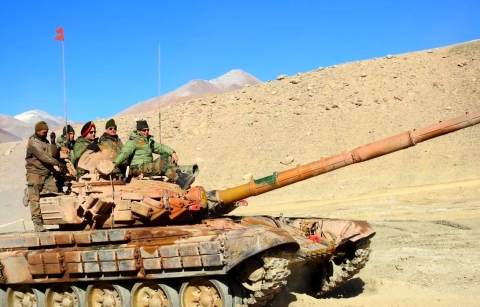 Here again the Chinese intelligence agencies had not kept pace with actual capabilities of the army to move their tanks with necessary back up infrastructure. Even the Indian Air Force displayed their efficient operational management by swiftly moving its transport and armed helicopters. They patrolled the skies and mastered night flying thereby demonstrating their flying skills under most adverse conditions. The ability of army units and formations to manage such large force levels and administer them did not go unnoticed by the PLA top brass.
Here again the Chinese intelligence agencies had not kept pace with actual capabilities of the army to move their tanks with necessary back up infrastructure. Even the Indian Air Force displayed their efficient operational management by swiftly moving its transport and armed helicopters. They patrolled the skies and mastered night flying thereby demonstrating their flying skills under most adverse conditions. The ability of army units and formations to manage such large force levels and administer them did not go unnoticed by the PLA top brass.
6. MORALE AND MOTIVATION
Despite the heavy losses suffered on 15 June in the Galwan clash, the morale of Indian troops never wavered. Promptly recognizing their valor the Government and the public stood behind the brave soldiers. Those who attained martyrdom were honored in their native homes by local administration and were given ceremonial farewell. The families of martyrs were compensated for the loss of their beloved who had sacrificed their lives for the nation. These action strengthened the determination and morale of the fighting soldiers.  The visit of the nation’s Prime Minister and the Defence sent strong messages that the political leadership was firmly behind the army. A slew of measures were announced to upgrade the war efforts. These had ensured that the morale and motivation of the military was kept high. These were all publicized by hundreds of TV channels owned not by Government media but private players. Chinese people on the hand are kept totally in the dark. The Communist Party is wary of the outcome of truth. Sooner or later they will face the ire of the masses.
The visit of the nation’s Prime Minister and the Defence sent strong messages that the political leadership was firmly behind the army. A slew of measures were announced to upgrade the war efforts. These had ensured that the morale and motivation of the military was kept high. These were all publicized by hundreds of TV channels owned not by Government media but private players. Chinese people on the hand are kept totally in the dark. The Communist Party is wary of the outcome of truth. Sooner or later they will face the ire of the masses.
7. CHINA’s FAILED PSY OPS
China which has always laid stress on Psy operations as an integral part of its military operations failed to use it effectively this time. By putting out amateurish videos, badly doctored old video clips the whole effort was ham handed and an exercise in futility.  The timing and the narrative of the Psy ops did not match with action on ground. They were poorly coordinated and did not have the necessary impact on the Indian military. Apparently China had not kept pace with its its archaic methods. Chinese techniques looked too outdated and crude. In today’s world with free information flowing and transparency China’s methods needs to be a lot more subtle and sophisticated. In comparison Indian army dropping pamphlets over Dacca garrison calling upon the besieged Pak troops to surrender was a classic example of a spy operations.
The timing and the narrative of the Psy ops did not match with action on ground. They were poorly coordinated and did not have the necessary impact on the Indian military. Apparently China had not kept pace with its its archaic methods. Chinese techniques looked too outdated and crude. In today’s world with free information flowing and transparency China’s methods needs to be a lot more subtle and sophisticated. In comparison Indian army dropping pamphlets over Dacca garrison calling upon the besieged Pak troops to surrender was a classic example of a spy operations.
8. BATTLE EXPERIENCE
China last fought a war in 1979 against Vietnam and had received a bloody nose denting its image as a superior army. Since then the PLA has not faced any enemy on the battle field. With forty percent of PLA comprising of conscripts there is a severe motivational crisis. PLA cadres lack any motivation to fight . To keep them in high morale is not easy especially in Galwan areas were the mountain heights are above 16000 feet. Most of Chinese garrisons stationed in Tibetan plains are not conditioned to adapt to the harsh weather where as Indian troops have vast experience in high altitude warfare.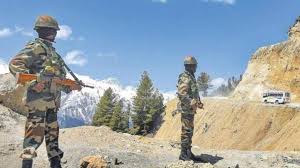 Chinese leadership realized that fighting in this area cannot be sustained against Indian army whose troops had dug in and were ready for a long fight.
Chinese leadership realized that fighting in this area cannot be sustained against Indian army whose troops had dug in and were ready for a long fight.
9. ATYCHIPHOBIA
This is no Mandarin word. It is an English word borrowed from Greek, meaning ‘fear of failing’.’ China suddenly realized that there was a real possibility that if push came to shove India meant business. It was a risky gamble to attempt any misadventure. The stakes were too high to lose the war. Indian political and military leadership were fully prepared to not just to take on China but even a two front war with Pakistan joining the conflict to put pressure on India. China’s dilemma was to find a face saver and an escape route. It had to find a way out. An excuse had to be invented.
It was a risky gamble to attempt any misadventure. The stakes were too high to lose the war. Indian political and military leadership were fully prepared to not just to take on China but even a two front war with Pakistan joining the conflict to put pressure on India. China’s dilemma was to find a face saver and an escape route. It had to find a way out. An excuse had to be invented.
10. WORLD PRESSURE
China realized that it had too many enemies and in case of a prolonged conflict very few nations would support her. The sudden spurt in Indo-US relations and formation of QUAD were developments put China on the back foot. China miscalculated that India would be burdened with the pandemic Covid -19 and concede to China her demands.  This plan had backfired with India having handled the pandemic with extraordinary managements skills. China’s hand in the spread of Covid 19 virus also nicknamed Wuhan virus dented its image in the international comity of nations calling for a ban on any trade with her. This led to an exodus of MNCs from China to India and other countries. China’s business interests took a big hit with India banning 59 Chinese apps and rescinding some top Government contracts. China had become the villain in the eyes of a civilized world.
This plan had backfired with India having handled the pandemic with extraordinary managements skills. China’s hand in the spread of Covid 19 virus also nicknamed Wuhan virus dented its image in the international comity of nations calling for a ban on any trade with her. This led to an exodus of MNCs from China to India and other countries. China’s business interests took a big hit with India banning 59 Chinese apps and rescinding some top Government contracts. China had become the villain in the eyes of a civilized world.
It had dawned on China that the odds stacked against her were too many. The whole plan had gone awfully wrong. China realized that its plan had been scripted in a haste. It had taken nearly forty long weeks for China to try all four methods of Chanakya’s famous principle of Sama, Dama, Bedha and Danda to discipline an opponent. China finally stuck to the wisdom of Sun Tzu who had advocated that when enemy is strong retreat. Realising that discretion is better part of valor‘ it, sensibly withdrew, without as much as a whimper. China is no rookie. She realizes that a tactical withdrawal at times is required. Finally neither Chanakya not Sun Tzu mattered. It was the words of Tacitus, the greatest Roman historian which came handy. ‘He who runs away lives to fight another day.’ Let us wait and watch. Like they say ‘Picture abhi baki hai‘.



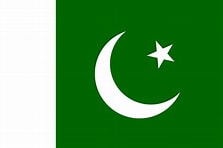




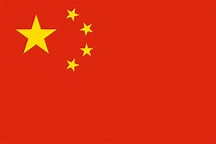
Cheers regarding the post and I find yourself being back to read a lot more! Just looking at some blogs, seems a reasonably nice system you happen to be utilizing. Im currently making use of WordPress for some my blogs but Im not happy with it up to now. Im searching to alter 1 of these more than to some platform similar to yours (BlogEngine) like a trial operate. Anything in particular youd suggest?